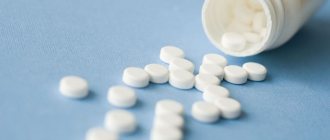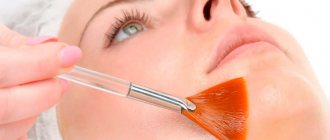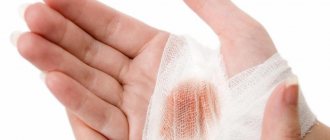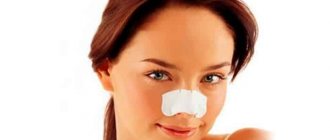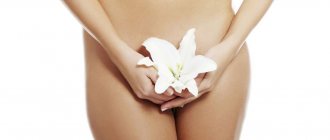Burns occur for a number of reasons. Damage may occur due to careless handling of hot liquid, steam or chemicals. Combustible substances pose a danger. Once they get on your clothes or shoes, you can forget about them. If a person is close to a fire and carelessly throws a match, then the fuel ignites. In this case, a burn with gasoline or kerosene leads to irreversible consequences.
In the article we will look at how to burn with gasoline, how to provide assistance if a person is burned, as well as how to treat and smear the affected areas.
Severity of burn injuries
Unlike acid, which causes dry coagulation of skin protein and creates a protective dry scab, alkali penetrates more deeply, liquefies and loosens tissue, and the damaged surface has a whitish-gray “cooked” appearance. Therefore, minor burns from alkalis are very rare.
If assistance is not provided, the severity of the burn increases due to the penetration of the substance deep into the tissue. Only a doctor can accurately determine the severity of alkali burns.
There are 4 degrees according to the depth of tissue damage:
- I – partial damage to the surface layer of the skin (epidermis), manifested by swelling and redness,
- II – complete liquefaction of the epidermis, manifested by its wrinkling, detachment, formation of watery blisters,
- III – is divided into 2 degrees: IIIA with damage to the skin itself up to the basal layer and IIIB with damage to the entire thickness of the skin with the basal layer up to the subcutaneous fatty tissue, manifested by the presence of deep wet wounds with dark areas of necrosis,
- IV – underlying tissues are destroyed along with the skin: muscles, ligaments, bones, looks like a black-gray area with a continuous wound surface, complete loss of skin sensitivity.
A burn is tissue damage that occurs under the influence of high temperature, electric current, acids, alkalis or ionizing radiation. Accordingly, thermal, electrical, chemical and radiation burns are distinguished. Thermal burns are the most common, accounting for 90-95% of all burns.
The severity of the burn depends on the depth of tissue damage and the area of its spread.
When 10% of the body area is affected, severe general phenomena called burn shock and burn disease occur. Painful shock causes changes in the central nervous system, and evaporation of the liquid part of the blood (plasma) from the surface of the burn and poisoning of the body with decay products of dead tissue disrupt the functions of internal organs.
First aid depending on the degree of burn
1st degree burn: treat the burn surface with alcohol or vodka, cover with a sterile cloth and apply cold, give painkiller medicine. The use of cold is especially effective in the first minutes after a burn and in most cases avoids burn shock.
2nd-4th degree burns: do not open the blisters, and do not cut off the opened ones, but carefully apply them to the wound. You can treat the burn surface with foaming aerosols, cover with a sterile napkin and apply cold, give a painkiller and drink plenty of fluids until the ambulance arrives.
Panthenol aerosol and others are applied to burn wounds.
Forbidden:
To quickly stop the action of chemical agents that have come into contact with the skin, the affected surface is washed with running water for 10-30 minutes. Then, for burns with acids, wash with sodium bicarbonate solution; for burns with alkalis, wash with a weak solution of acetic acid and apply an aseptic bandage.
With a large area of burns, measures must be taken to prevent shock. To do this, the victim must be positioned so that he is less bothered by pain, and provided with warmth and plenty of fluids. You can give hot tea or coffee.
Burn of the esophagus and first aid for it
A burn to the esophagus occurs due to unintentional or intentional ingestion of an aggressive liquid (acid or alkali). Immediately after swallowing, burning pain occurs along the esophagus and in the epigastric region, intense salivation, and vomiting. With concomitant burns of the larynx and vocal cords, hoarseness, difficulty breathing, and asphyxia appear. The victims are pale, frightened, breathing and heartbeat are rapid, swallowing is impossible. The development of shock with symptoms of burn toxemia cannot be ruled out: hyperthermia, arterial hypotension, muscle twitching, the appearance of agitation with delirium.
Urgent Care. Clean and rinse your mouth. For acid burns, give 2% solution of sodium bicarbonate, burnt magnesia, almagel to drink; for burns with alkalis - 1% acetic acid solution. To prevent shock, analgesics are administered, and to relieve esophageal spasm - atropine, papaverine, ganglion blockers. Emergency hospitalization.
First aid for chemical burns.
First aid for burns with acid or alkali consists of immediately washing the affected surface with a stream of water to reduce the concentration of the acid or alkali and stop their action.
After washing with water, it is necessary to begin neutralizing the acid residues.
2% solution of baking soda, and for burns with alkali - 2% solution of acetic or citric acid.
Sunstroke or heatstroke - first aid
Emergency care for sunstroke and heatstroke should be aimed at cooling the body as quickly as possible. For this purpose, both general (immersion in a bath of water at 18-20°C, wetting the victim’s skin with water at room temperature and blowing with warm air) and local hypothermia (ice on the head, axillary and groin areas, wiping with sponges moistened with alcohol) are used. When cooling, the victim often experiences motor and mental agitation.
First aid: put the victim in the shade, in a cool place in a horizontal position: remove clothes, free breathing; provide access to fresh air; place in a cool place; unbutton clothes; improve ventilation.
It is unacceptable to drink water, as this will further increase sweating and lead to a rise in body temperature and increased heart rate.
If breathing stops or is suddenly disrupted, it is necessary to start mechanical ventilation. When the patient comes to his senses, give him a cool, plentiful drink (strongly brewed iced tea).
Providing first aid for alkali burns
The main task when providing first aid is to stop the action of the alkali, clean the surface of the wound, and protect it from infection. What to do if you are burned by alkali:
- Eliminate skin contact with alkali. To do this, you need to quickly free the damaged area from contact with clothing soaked in the substance and place it under running water for at least 20 minutes.
If dry quicklime gets on your skin, it should not be washed off immediately with water. This will create an alkaline solution and worsen the burn. First you need to shake off, blow off, remove the powder from the skin with a soft cloth and only then rinse with water.
- Neutralize the remaining alkali on the skin with a weakly acidic solution - 1-2% boric or citric acid, vinegar, lemon juice diluted with water 1:4. This can be done if it is known for sure that alkali has come into contact with the skin. In doubtful cases, neutralization with acid may lead to an undesirable chemical reaction and deterioration.
- Treat the wound with any antiseptic solution (miramistin, chlorhexidine, furatsilin) or a special anti-burn spray.
- Cover the wound with an aseptic gauze bandage.
- Take the victim to the hospital.
If necessary, give the patient an anesthetic, and for extensive burns, drink plenty of fluids.
First aid for thermal, chemical and electrical burns
An accident can result in victims receiving thermal, electrical and chemical burns. Thermal burns can be caused by exposure of the skin to high temperatures, fuel ignition, car fire, etc.
Chemical burns can occur from exposure of the skin to alkalis and acids resulting from the destruction of the battery.
An electrical burn occurs when exposed to electrical current. For example, in an accident you hit power lines or lighting poles.
In these cases, it is extremely important to properly assist the victims and not get hurt yourself. In this article we will tell you about the rules of first aid for thermal, chemical and electrical burns. So…
First aid for thermal burns
When providing first aid for thermal burns, first stop the impact of the damaging factor on the victim and determine the degree of the burn. The more severe the burn, the higher the temperature of exposure, the longer the contact with the damaging factor and the larger the area of influence. The larger the area and depth of the burn, the more dangerous it is to human life. If 1/3 of the surface of a person’s body is damaged, then this threatens his life.
With a first degree burn, the victim experiences pain, redness and swelling. Treat the affected area with cold water, apply anti-burn ointment and a sterile bandage. Oils and ointments cannot be used!
With a second degree burn, blisters with a clear or yellowish liquid are observed. Under no circumstances should you puncture or cut off blisters or expose them to cold water. The burn is treated with anti-burn ointment or synthomycin emulsion.
Third-degree burns are characterized by the presence of large blisters with bloody fluid, a thin or dry scab, whitish-brown in color. There will be reduced or no pain sensitivity at the burn site. Cover the burn site with sterile material.
IV degree burn is the most severe, in which charring appears.
When calling an ambulance to the scene of an accident, be sure to report that the victim has burns.
If your clothing is on fire, you should not run around trying to put it out. Clothes are extinguished by stopping the access of air, namely, the victim is covered with a tarpaulin, blanket, etc. Remove or carefully cut away any areas of clothing that are peeling. If clothes are stuck, they should not be torn off. A sterile dry bandage is applied to the burns, and if the burns are extensive, the victim is wrapped in a sterile sheet.
Remember that covering the victim’s head with a tarpaulin and removing any areas of clothing stuck to the burn site are prohibited. A sterile dressing is applied to the adhesive areas of clothing, as well as ointments and liquid treatments.
If the victim is vomiting, he is placed on his side. If there is no vomiting or damage to internal organs, then give him plenty of salt water to drink (1 teaspoon of salt dissolves in a liter of water).
First aid for chemical burns
An acid burn appears on the skin as a limited yellow spot, which must be washed with water tangentially to the surface of the burn, and then neutralized with a slightly alkaline solution (soap or soda), and covered with a sterile bandage.
A burn from concentrated sulfuric acid will be a dark brown spot on the skin, and it is prohibited to wash it with water, but can only be treated with a slightly alkaline solution (soap or soda).
Give the victim an alkaline drink, diluting 1 tsp into a glass of water. baking soda.
If electrolyte gets on the face, the burn site is washed tangentially to the nose, and 2 drops of sodium sulfacyl should be dripped into the eyes.
In the case of a burn from alkalis, the stain on the skin will be gray and smudged. The burn site should be washed tangentially and neutralized with a weakly acidic solution of citric, boric or acetic acid, after which a sterile bandage is applied.
Electrical burn
When providing first aid for an electrical burn, the effect of electric current on the person should be eliminated. If the electric current voltage is less than 1000 V, then de-energize the wire by cutting it with a tool with a dry wooden handle or cutting each phase separately using wire cutters with insulated handles. If possible, simply de-energize the line.
If it is not possible to de-energize the wires, then it is necessary to take safety measures so as not to get hurt yourself. Wear rubber shoes, use a car mat or camera, and dry boards. Clothing and gloves should also be dry. Take a dry wooden stick, wrap your hands in a dry cloth or jacket, and use a non-conductive object to remove it from the affected wire.
If the current is over 1000V, then you will need special equipment designed for this voltage: rubber boots, dielectric gloves, a special insulating rod.
When the body comes into contact with electric current, a burn occurs. A sterile dry bandage is applied to the affected area of the body.
When a victim is struck by an electric current, the current passes through the entire body, disrupting the nervous system and causing tonic muscle contraction.
Clinical death of the victim may occur, which requires artificial respiration and chest compressions.
Surgeon L.K. Levshunova
What should you not do if you have a burn?
In case of an alkali burn, you should not immediately water the damaged area with an acidic solution without first rinsing it with water. A chemical reaction can make the condition worse, especially if it is not known which solution came into contact with the skin.
Also, you should not immediately try to wipe the solution from the skin with a napkin or piece of cloth, this will further injure the wound. Neither before nor after washing the wound is it permissible to apply fats, oils, or fatty creams to it. They clog skin pores, disrupting breathing and thermoregulation, creating conditions for the development of infection.
Treatment of burn wounds at home
If the burn wounds are small and not very deep, then treatment of the burn with alkali can be carried out at home using medications prescribed by a doctor, supplementing them with folk remedies, if possible. You need to visit your doctor regularly and follow his recommendations.
Use of drugs
Alkaline burns are dangerous because infection easily develops in areas of wet necrosis. Therefore, in the acute stage, antibacterial agents are prescribed - antiseptic solutions. They moisten a sterile napkin and change it 2-3 times a day until the wound is completely cleansed and “dried” so that there is no purulent discharge. Solutions of Miramistin and Chlorhexidine work well.
To quickly remove necrotic tissue, Iruksol enzyme ointment is widely used; it dissolves dead areas and has an antiseptic effect. First, the wound is washed with an antiseptic, then ointment is applied for a day.
A cleansed granulating wound needs agents that stimulate the healing process. The most effective ointments are Solcoseryl, Actovegin, and if there is still a lot of discharge, use a Peloidin solution prepared on the basis of medicinal mud. Wound dressings are done once a day.
Traditional methods
Among the folk methods for burns, the application of all kinds of gruels and mixtures of grated vegetables, fats and oils should be excluded. Preference should be given to products that undergo heat treatment. You can treat alkali burns with decoctions and herbal infusions:
- daisies,
- Calendula,
- mint,
- Hop cones,
- St. John's wort.
The possibility of using any folk medicine for burns must be agreed with a doctor.
You can prepare an herbal mixture by taking equal parts of each component, brew 1 tablespoon of the mixture with a glass of boiling water, it is better to hold it in a water bath for 10-15 minutes, then strain into a boiled bowl and cool. Apply to the wound on a moistened sterile napkin 2-3 times a day.
Freshly squeezed juice of aloe or Kalanchoe leaves gives a good antibacterial and wound-healing effect.
It is carefully squeezed into a clean container, moistened with a sterile napkin, and applied to the wound daily. A decoction of oak bark and strong tea brewing will help relieve pain and itching around the wound. Prepare at the rate of 1 tablespoon per 1 glass of boiling water, leave on low heat for 5 minutes. Apply several times a day for half an hour.
Burn treatment
Any degree of injury above 1 requires hospitalization of the patient. The doctor will determine the extent of the burn lesions and prescribe a course of restorative medications for tissue healing. The most serious stages will require surgery.
Drug therapy
Chemical burns require treatment at home or in a medical facility. Stages 1 and 2 are treated by patients at home, but grades 3 and 4 are treated in hospitals. The rehabilitation course is selected by the attending physician. It includes several groups of medications.
Antiseptic preparations that disinfect tissues must be used. Their use is necessary to avoid possible infection and suppuration. The speed of healing depends on this. Chlorhexidine, Miramistin, Furacilin and other agents are used to treat the skin surface.
Treatment involves the use of healing ointments or sprays. They can have a combined effect, for example, not only restore tissue, but also kill pathogenic microorganisms, and also relieve pain. The most common ointments containing dexpanthenol, Radevit ointment, Olazol spray.
If the drugs do not combine several properties, antibacterial and painkillers are additionally prescribed.
Folk remedies
Traditional therapy methods are allowed to be used after consultation with the attending physician. The funds are used after the tissues have already restored their basic functions. The following folk methods of treating burns have proven themselves well:
- decoctions of pharmaceutical herbs (chamomile, oak bark, St. John's wort);
- compresses from fresh grated potatoes;
- sea buckthorn and fir oil;
- fresh aloe juice and in the form of compresses;
- cabbage leaf, which is applied to the affected area.
Physiotherapy
This method is used after the wounds have healed. Physiotherapy promotes rapid cell regeneration. By improving the functioning of the circulatory system and stimulating metabolic processes, damaged areas heal faster. Ultraviolet and infrared waves and ultrasound are used as methods of physiotherapy.
Eye burn from alkali
When a liquid alkali solution gets into the eyes, a tear partially reduces its concentration and washes it away. Therefore, severe eye burns occur with heavy exposure to alkali, especially quicklime dust.
Interacting with the thin membranes of the eye, they destroy them, causing clouding and blurred vision. The conjunctiva of the eyelids and lacrimal ducts are also subject to burns, and in case of severe damage, deeper layers are affected, right down to the retina.
The first thing to do if alkali gets into your eye is to rinse it thoroughly with running water under the tap or from a bottle.
In this case, it is necessary to keep the eyelids open and slightly retracted so that the water completely washes the entire surface of the eye and the conjunctiva of the eyelids. The position of the patient's body should be such that the rinsing water flows outward - towards the temple area.
After this, rinse the eye well with a 1-2% aqueous solution of boric acid to neutralize the remaining alkali. Then the eye is covered with an aseptic bandage, and the patient is taken to the doctor.
Publications in the media
Chemical burns of the esophagus are caused by concentrated alkalis and acids. Causes. Accidental or deliberate (with suicidal intent) ingestion of concentrated acids (acetic essence, battery electrolyte) or alkalis (ammonia, caustic soda).
Pathogenesis • Local action •• Acids cause coagulative necrosis with the formation of a dense scab, which prevents the substance from penetrating deeper and reduces its penetration into the blood •• Alkalies cause liquefaction necrosis, which promotes the transfer and spread of alkali to the underlying initially undamaged tissues • General toxic effect with the development of multiple organ failure ( primarily hepatic-renal).
Pathological anatomy • Alkali burns are characterized by deeper and more widespread damage to the wall of the esophagus • The most pronounced changes occur in places of physiological narrowing • Stages of the burn •• I - hyperemia and edema of the mucous membrane •• II - necrosis and ulceration of the mucous membrane •• III - formation of granulation tissue •• IV - scarring • By the end of the first week, necrotic areas are rejected, forming ulcerations. Superficial ulcers epithelialize within 1–2 months, deep ulcers within 2–6 months with the formation of connective tissue.
Clinical picture • Stage I (acute) - 5–10 days •• Pain in the mouth, pharynx, behind the sternum, in the epigastric region •• Hypersalivation •• Dysphagia •• Shock in the immediate hours after injury •• Burn toxemia, the symptoms of which begin prevail in a few hours • Stage II (imaginary well-being) - 7–30 days. As a result of the rejection of necrotic tissue, swallowing becomes somewhat freer. Complications: •• esophageal bleeding •• perforation of the esophageal wall •• sepsis • Stage III (stricture formation) - from 2 to 6 months, sometimes for years. On the wall of the esophagus, areas of varying length are formed with a sluggish healing process, the wound surfaces are covered with scabs and bleed easily. Dysphagia to the extent of complete obstruction of the esophagus; laryngospasm, cough, suffocation caused by food entering the respiratory tract.
TREATMENT Diet. Liquid, tube and parenteral nutrition are recommended. Conservative treatment • Narcotic analgesics - trimeperidine, omnopon • Washing the oral cavity and stomach with solutions of antidotes in the first hours after the chemical enters the esophagus • Drinking plenty of fluids (water, milk) followed by inducing vomiting as first aid at the scene • Mandatory early (in the first hours) gastric lavage (fluid volume from 1 to 5 liters depending on age) • Intensive antishock therapy • Antihistamines with a pronounced sedative effect (promethazine, chloropyramine) • Detoxification therapy • With the development of acute renal failure - extracorporeal blood purification • Infusion therapy with forced diuresis, antibiotic therapy • GK • Fish oil, vegetable oil orally • Early start (2 months after the burn) of bougienage of the esophagus for 1–1.5 months in combination with GK and lidase • At the stage of stricture formation, bougienage is the main method of treatment • • Blind •• Hollow radiopaque bougies over a metal guide •• Under the control of an esophagoscope •• Based on the principle of bougienage without end (bougienage with a sequential increase in the diameter of the bougies during one procedure using a gastrostomy - the bougies are passed through the oral cavity, esophagus and gastrostomy) •• Retrograde (through gastrostomy tube).
Surgical treatment • For segmental strictures - partial plasty of the esophagus • For extensive strictures - total plasty of the esophagus with presternal or intrasternal placement of a graft from the small or large intestine. Complications • Cicatricial narrowing of the esophagus • Intravascular hemolysis in burns with vinegar essence • Aspiration pneumonia • Psychosis • Sepsis.
ICD-10 • T28.6 Chemical burn of the esophagus
Possible complications
Complications of alkali burns can be general and local. General ones develop in case of extensive and deep damage:
- Burn hypovolemic shock due to fluid loss,
- Poor circulation due to blood thickening, thrombosis,
- Impaired liver and kidney function associated with intoxication,
- Sepsis due to infection of extensive burn surfaces.
Local consequences can be in the form of wound suppuration, prolonged non-healing, the formation of rough keloid scars that limit mobility or are a cosmetic defect.
On the part of the eyes, the most common development is clouding of the cornea - a cataract; with severe burns, the deeper media of the eye are also affected, up to complete loss of vision.
When should you see a doctor?
It should be taken as a rule that in case of a burn with alkali, regardless of its area and location, it is necessary to consult a doctor. The degree of the burn is difficult to immediately determine, especially for a person without medical education.
In case of burns to any area of the body, the victim must be taken to a trauma center, or the emergency department of traumatology or surgery.
For minor burns, you can see a surgeon or traumatologist at the clinic. Eye burns should be examined by an ophthalmologist as soon as possible. If the injury occurred in a rural area where there is no hospital nearby, you must contact a paramedic-midwife station. The paramedic will provide first aid and decide on further actions.

